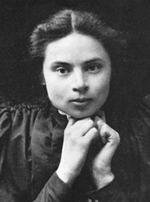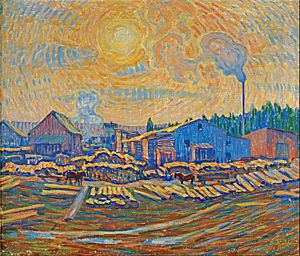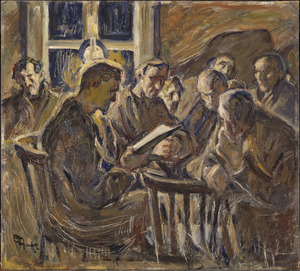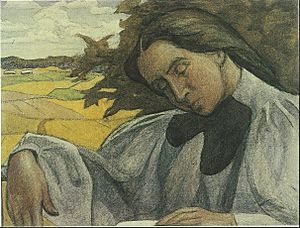Ester Almqvist facts for kids
Ester Dorothea Almqvist (born November 3, 1869 – died June 11, 1934) was a Swedish artist. She was a very important early painter of Expressionism in Sweden. Expressionism is a style of art where artists show their feelings and ideas rather than just what things look like.
Contents
Early Life and Learning About Art
Ester Almqvist was born in Bromma, Sweden. She grew up in Stockholm. Her parents were teachers at a school for Christian missionaries. When she was nine years old, her father, who was a priest, passed away. Her mother then worked as a private tutor and sold books to support the family.
Ester was born with a curved spine. This made it hard for her to move around easily throughout her life. However, this also meant she could focus on studying art instead of doing housework.
Art School and Teachers
Ester started her art journey at the Technical School in Stockholm. She finished there in 1891. She also took private art lessons from a painter named Gustaf Cederström.
She continued her art studies at the Valand Art Academy in Gothenburg from 1892 to 1893. After that, she went to the Konstnärsförbundets skola in Stockholm from 1894 to 1895. Some of her teachers were famous artists like Per Hasselberg and Bruno Liljefors. While she was a student, she earned money by drawing pictures for books. Later, she joined a group for women called Nya Idun.
Her Art Career
Ester Almqvist lived and worked for most of her life in Lund. Many of her well-known paintings show the beautiful areas around Skåne province. She started showing her art in the late 1890s. She even showed her work at the St. Louis World's Fair in 1904.
Changing Art Styles
At first, Ester Almqvist's paintings were in the style of Impressionism. This style often showed soft, gentle feelings. After her mother passed away, her art changed a lot. She started painting in the Expressionism style.
Her later paintings, from about 1913 onwards, look a lot like the work of Vincent van Gogh. She used strong, bold brushstrokes, bright colors, and thick lines. These paintings showed powerful emotions and ideas.
Recognition and Legacy
Ester Almqvist was part of a group of Swedish women artists. They traveled, worked, showed their art, and sometimes lived together. Some of these artists included Tora Vega Holmström and Maja Fjæstad.
In her last year, Ester had a lot of back pain and could not paint. A younger group of women artists, like Vera Nilsson, organized an art show in Stockholm to honor her. They saw her as an important early Swedish modernist artist. However, more people truly recognized her work after she passed away in 1934.
Ester wanted her art to be given to the Malmö Art Museum. This museum now has over 2,000 of her artworks. Her paintings are also in other important places like the Swedish National Museum and the Gothenburg Art Museum. Today, she is known as a pioneer of Expressionism in Sweden.
In 1992, one of her paintings called The Meeting (in Swedish, Sammankomsten), from 1929, was chosen for a Swedish postage stamp. This stamp honored Article 20 of the Universal Declaration of Human Rights, which talks about the right to join groups freely.
Her personal papers are kept at Lund University.
See also
 In Spanish: Ester Almqvist para niños
In Spanish: Ester Almqvist para niños





